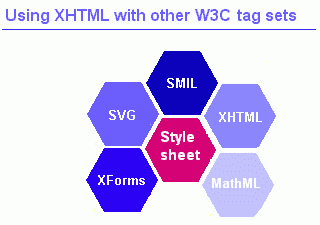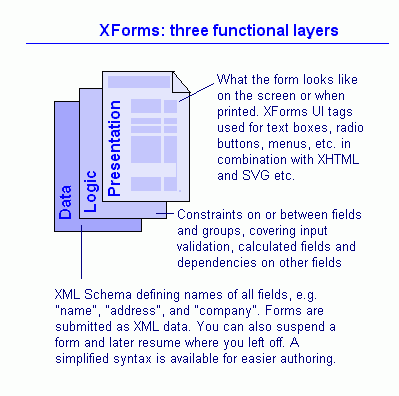Work on HTML is being managed as part of W3C's User Interface Domain
HTML - the Hypertext Markup Language - is the lingua franca for publishing on the World Wide Web. Having gone through several stages of evolution, today's HTML has a wide range of features reflecting the needs of a very diverse and international community wishing to make information available on the Web. HTML 4.0, created by W3C, became a Recommendation in December 1997. A revision, HTML 4.01 was published in December 1999.
During 1999, HTML 4 was re-cast in XML and the resulting XHTML 1.0 is now a W3C Recommendation. Work has continued during 2000 on modularizing XHTML and planning for the future.
XHTML brings the Web of the future to content authors today. It is a reformulation of HTML 4 in XML, bringing the rigor of XML to HTML, and can be put to immediate use with existing browsers by following a few simple guidelines.
W3C's work in XHTML helps create standards that provide richer Web pages on an ever increasing range of browser platforms including cell phones, televisions, cars, wallet sized wireless communicators, kiosks, and desktops.
XHTML is intended to be used in conjunction with tags from other XML applications, so that in principle, you can combine say, XHTML tags with SVG Graphics tags or XML tags from any other XML application.

To write XHTML you need to use the XML syntax, which is slightly different from that of the HTML you use today. What are the differences? XML requires you to:
XHTML uses lower-case for tags and attributes. Old browsers can render XHTML 1.0 provided simple guidelines are followed.
The XHTML Working Draft simply re-casts HTML 4.0 as an XML application. Meanwhile a second document is concerned with the modularization of XHTML. This document describes how XHTML can be organized as a number of modules used to mark-up headings, paragraphs, lists, hypertext links, images and other document idioms. Modules provide a means for subsetting and extending XHTML, a feature desired for extending XHTML's reach onto emerging platforms.

Each module consists of a number of tags. For example, there is a Text Module which includes h1-h6, p, pre, blockquote, em and other HTML tags at the level of text and paragraphs. There is a List Module which includes all the tags associated with creating lists. There is a Basic Forms Module, a Basic Tables Module, a Scripting Module, a Style Module and so on.
HTML forms lack a number of features common in software used in database and workflow applications - these are applications where an on-line document or form is passed from office to office; for example, an invoice or purchase order. W3C are now working on a complete revision to make forms more portable and easier to work with. The form fields will be tied to a definite data model and less to presentation, making it easier to use data in form fields for processing by other software; for instance, to generate reports, statistics etc. The new XForms specification will also make it easier to cater for regional variations for currency values, phone numbers, dates and postal addresses, and make it possible to cope with different kinds of input, e.g. microphones, cameras, scanners and pen-based input for signatures and drawings.

It will become increasingly common for peripheral devices to include embedded Web servers. XForms have the potential for configuring peripherals without the need for custom device drivers. For example, suppose you want to do the page set-up for printing. An XForm might provide the interface to configure the printer via its own embedded Web server, literally a server installed in the printer. This is on the assumption that all the devices will be connected to the network in some manner. Further information is available on the XForms page.
People will, in future, want to access the Web not just from desk-top computers, but also from from cellular phones, pagers, in-car computers, palm-top computers and other small devices. As new kinds of device are used to browse Web pages, so authors will be anxious to make information available on these, too. For instance, suppose you design a series of Web pages for a desk-top computer. You will also want people to be able to access those same pages via a small portable device with only a small screen showing just a few lines at a time.
The HTML Activity has two working groups:
The HTML Working Group hopes to reduce the costs of authoring documents for delivery to a wide range of devices, and, at the same time, to permit the evolution of Web pages with richer forms, graphics, mathematics, time-based effects and so forth. We work in cooperation with appropriate W3C groups and activities. Promotional materials and activities are planned to encourage the development of authoring tools, browsers and good practices for the next generation of HTML.
The Working Group is working on guidelines and tools for transforming HTML 4.0 documents to be well formed XML syntax. The Working Groups is also addressing transition issues, for example, whether it's appropriate to label such documents as text/html and if so, how to allow such documents to remain viewable on installed browsers, is also on the agenda.
Liaison with other related W3C groups and activities, for example to ensure that HTML meets W3C goals for accessibility and internationalization, is an important aspect of the Group's work.
The XForm Working Group started life as a subgroup with the HTML Working Group, and was then spun off as an independent working group. It aims to build upon the experience gained over the early years of the Web to create the basis for the next generation of Web applications. This has led to a focus on separating the data, logic and presentation, reducing the need for complex scripting and the number of round trips to the server. On the server, it will allow code to shared for different versions of Web pages aimed at different devices (voice, mobile, television, desktop and even paper).
The first W3C HTML working group owed its origins to discussions initiated in 1995 by W3C for resolving interoperability concerns for browsers from different vendors. The group developed the W3C Recommendation for HTML 3.2 and subsequently for HTML 4.0. The group then closed.
Following the workshop on the future of HTML, held in 1998, a second HTML working group was chartered to reformulate HTML as a modular application of XML. The second HTML working group produced W3C Recommendations for HTML 4.01 (a maintenance release superceding HTML 4.0), and for XHTML 1.0 (a reformulation of HTML 4.01 in XML). Working drafts have been published and progressed to last call for XHTML Modularization, XHTML Basic, XHTML 1.1 with the exception of XHTML Events. This all took longer than envisaged and the HTML Working Group was rechartered to continue this work, and has recently moved XHTML Modularization to Candidate Recommendation status. Implementation experience with XHTML Basic is allowing it to move straight to Proposed Recommendation status.
The HTML Working Group is now developing new modules for XHTML, for instance, XHTML events, and improved ways to handle compound documents. This work is expected to lead to a specification for XHTML 2.0 that brings together the new modules, including XForms and Ruby (phonetic annotations for Kanji). The Group also plans to develop a CC/PP vocabulary for XHTML, making it practical to use CC/PP to specify which modules of XHTML are supported by a given device.
The HTML Activity has also hosted work on a W3C Open Source tool for cleaning up HTML and converting it to XHTML (HTML Tidy). This has been very popular and has been integrated into numerous HTML authoring tools. Tutorials for using HTML and CSS have also proved popular.
Following the creation of an independent working group for XForms, the focus has shifted to exploiting XML Schema for defining the data models for forms. XForms specific properties for dynamic constraints are handled via annotations to XML Schema. A simplified syntax is also under development when easier authoring is of paramount importance. Other work is looking at the user interface and the protocols for submit, suspend and resume. This is leveraging W3C's work on XML Protocols.
The XForms Working Group has published an updated requirements draft, and expects to publish new drafts soon for the XForms architecture, the data model and dynamic constraint language, and the XForms user interface and binding mechanism. The XForms architecture allows Web designers to specify a platform independent data model, which can be re-used for a wide variety of ways for accessing Web services, e.g. mobile, voice, television and desktop systems.
The next phase of work on HTML will seek to build on the transition to XML, with continued work on modularization, work on XML Schemas for XHTML, and registering an Internet Media Type for XHTML following the guidelines set out by the W3C-IETF liaison group studying Internet Media types for applications of XML.
W3C's work on areas such as math, scalable vector graphics, synchronized multimedia, voice browsing, forms and privacy preferences holds great promise for a new generation of Web pages. Work on XHTML on its own and without new features is of limited appeal. As a result, work is now needed on combining XHTML with W3C's other work, and for W3C to take a leadership role in promoting the resultant document types as the new baseline for browser interoperability. The HTML working group will need to collaborate with other working groups to assist W3C in reaching this goal.
Work on XForms has grown in importance to the point where it is becoming a building block for other W3C specifications. The key idea is to separate the user interface and presentation from the data model and logic, allowing the same form to be used on a wide variety of devices such as voice browsers, handhelds, desktops and even paper. XForms brings the benefits of XML to Web forms, transferring form data as XML. XForms aims to reduce the need for scripting, and to make it easier to achieve the desired layout of forms fields without having to resort to using nested tables etc.